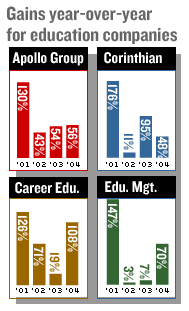NEW YORK (CNN/Money) -
When investors start to see stocks with gains of up to 1,000 percent over the last four years, flashbacks of the tech bubble may appear. But the heady returns of education companies may be on more solid ground.
Students flocked to education as the economy soured, companies laid off workers and people returned to school in hopes of eventually finding work in an increasingly-competitive work environment.
"In a weak labor market, people go to these schools to finish their degrees or get more credentials in hopes of eventually re-entering the work force,'" said Michael Jaffe, equity analyst with Standard & Poor's.
“ If you look at where else you can find this type of revenue, cash flow and earnings growth, the choices are pretty limited. ”
Mark Hughes
Analyst, SunTrust Robinson Humphrey
|
Since 2000, the United States lost nearly two million jobs, while education institutions handed out approximately 11.7 million associate, bachelor and graduate degrees, according to initial figures from the National Center for Education Statistics.
And rising enrollment growth has propelled shares of the largest education companies -- Apollo Group (APOL: Research, Estimates), Corinthian Colleges, Career Education and Education Management -- to trade around all-time highs.
Corinthian (COCO: Research, Estimates) and Career Education are up about 1,000 percent since 2000, Apollo is up about 500 percent and Education Management boasts a 400 percent gain.
That compares with flat results for the Dow and a slight loss for the S&P 500 since 2000.
But what happens if the economy continues to recover and people head back to work, as seen in the March payroll report, instead of to the classroom?
When there's work, why school?
The rapid growth for education companies and their stocks came during a soft labor market, but the driver behind the firms now is a supply versus demand situation, said Richard Close, analyst with Jefferies & Co.
"The Department of Education estimates there will be three million more undergraduates in 2013 than there are now," he said. "Some colleges have already started to limit enrollment, so the wind is at their backs in terms of demographics."
While most watching the education sector agree that growth is possible even as the labor market improves, they stress that the firms need to maintain relevant and diverse offerings to continue attracting students.

"There is a connection between education and the economy, but it's seen more clearly with short-term programs," said Mark Hughes, analyst with SunTrust Robinson Humphrey.
And the companies, which typically consist of a network of campus-based and Internet courses, have a wide array of programs.
Some of the shorter-term offerings include everything from radiation therapy to diesel engine maintenance. The longer offerings include traditional degree programs in concentrations such as accounting and computer programming.
"The longer programs attract a lot of part-time students that haven't finished their college degrees and they'll go back to school to finish up regardless of the economy," Hughes said, noting that most of these students are part time and already have full-time jobs.
The program mix provides insulation during economic swings, so much so that the largest education firm Apollo Group doesn't factor the economy into its growth projections.
"Enrollment isn't cyclical," said Terri Hedegaard, spokeswoman for Apollo Group, which has seen huge growth in its University of Phoenix (UOPX: Research, Estimates) online unit.
"We may see a slight bump when the economy turns lower, but our growth has been steady and we don't factor the economy into our growth expectations because it doesn't really have an impact."
Growth and more growth
At first glance, the huge moves in education stocks over the last four years and their valuations compared to the broader market may give investors pause.
Corinthian, Career Education (CECO: Research, Estimates) and Education Management all have price-to-earnings ratios in the mid 30s and Apollo tops out at 50.5, well above the 17.8 P/E for the S&P 500.
Despite the premium P/E valuations, bets that the stocks will fall are relatively tame. Short interest in the stocks range from 4.6 percent of the stock float with Corinthian to 1.1 percent with Education Management.
This is slightly higher than Dow component General Electric at 0.3 percent, but lower than tech bellwether Yahoo at 8 percent.
Factoring in earnings growth for the companies also gives a different perspective to the stocks, as Wall Street expects them all to grow by at least 30 percent in 2004, according to research firm First Call.
On the heels of the soft labor market and increasing enrollment, the huge growth estimates may be easy to imagine. Yet, even before the economy weakened, the education sector posted similar growth rates, noted Jefferies' Close.
YOUR E-MAIL ALERTS
|
Follow the news that matters to you. Create your own alert to be notified on topics you're interested in.
Or, visit Popular Alerts for suggestions.
|
|
|
 |
"Even in '96, before the tech bubble, these companies had growth rates in the mid 20s to 30 percent," he said. "And the levels haven't changed much."
And as a group, the companies have PEG ratios, or price-to-earnings divided by growth, slightly below with the S&P 500's 1.7 as of April 5, according to First Call.
Apollo Group's PEG comes in at a sight premium to the S&P at 2.0, Education Management (EDMC: Research, Estimates) in line with the S&P at 1.7, and Corinthian and Career Education come in below at 1.4.
"If you look at where else you can find this type of revenue, cash flow and earnings growth, the choices are pretty limited," said SunTrust's Hughes. "And I'd think you'd pay for that."

|

